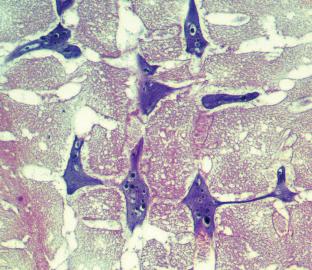一些古棘皮动物和大棘皮动物皮层中的细胞核组织。
IF 0.8
4区 生物学
Q4 BIOCHEMISTRY & MOLECULAR BIOLOGY
引用次数: 0
摘要
在中间宿主体内形成囊尾蚴的最后阶段,棘尾虫类(Archiacanthocephala)和古棘尾虫类(Palaeacanthocephala)的巨型鞘核会碎裂,但在以后的生活中仍彼此相连。可以推测,每个巨型被膜核的碎片相互连接,形成一个独立的网络,确保被膜的生命活动,在寄生虫在最终宿主体内密集生长期间,被膜的体积会增加许多倍。本文章由计算机程序翻译,如有差异,请以英文原文为准。


Organization of the Nuclei in the Tegument of Some Palaeacanthocephala and Archiacanthocephala
The giant tegument nuclei of the acanthocephalans of the classes Archiacanthocephala and Palaeacanthocephala are fragmented at the final stage of cystacanthus formation in the intermediate host, but remain connected with each other during later life. It can be assumed that the fragments of each giant tegument nucleus are united with each other to form an independent network that ensures the vital activity of the tegument, the volume of which increases many times during the period of intensive growth of the parasite in the definitive host.
求助全文
通过发布文献求助,成功后即可免费获取论文全文。
去求助
来源期刊

Doklady Biochemistry and Biophysics
生物-生化与分子生物学
CiteScore
1.60
自引率
12.50%
发文量
68
审稿时长
6-12 weeks
期刊介绍:
Doklady Biochemistry and Biophysics is a journal consisting of English translations of articles published in Russian in biochemistry and biophysics sections of the Russian-language journal Doklady Akademii Nauk. The journal''s goal is to publish the most significant new research in biochemistry and biophysics carried out in Russia today or in collaboration with Russian authors. The journal accepts only articles in the Russian language that are submitted or recommended by acting Russian or foreign members of the Russian Academy of Sciences. The journal does not accept direct submissions in English.
 求助内容:
求助内容: 应助结果提醒方式:
应助结果提醒方式:


